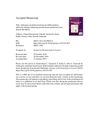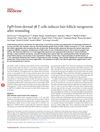Mutant Cx43 in Skin Differentiation and Disease
January 2011
TLDR Mutant Cx43 causes slower wound healing and hair growth issues in ODDD.
The study investigated the role of mutant Connexin43 (Cx43) in skin differentiation and disease, particularly focusing on oculodentodigital dysplasia (ODDD) and its effects on hair growth and wound healing. Using a mouse model of ODDD (G60S mice), researchers found that cutaneous wounds healed slower compared to wild-type mice, indicating impaired fibroblast and keratinocyte function. Fibroblasts from G60S mice and ODDD patients showed defects in proliferation, migration, and differentiation, while keratinocytes exhibited increased proliferation without migration changes. Organotypic epidermal cultures with mutant Cx43 showed reduced endogenous Cx43 and Cx26 levels, affecting skin structure. Hair regrowth in G60S mice was delayed due to reduced mitotic activity in hair follicle cells, resulting in thinner, shorter hair with structural abnormalities. The findings suggested that mutant Cx43 impaired fibroblast function during wound healing and reduced hair follicle epithelium proliferation, leading to hair growth defects in ODDD patients.


